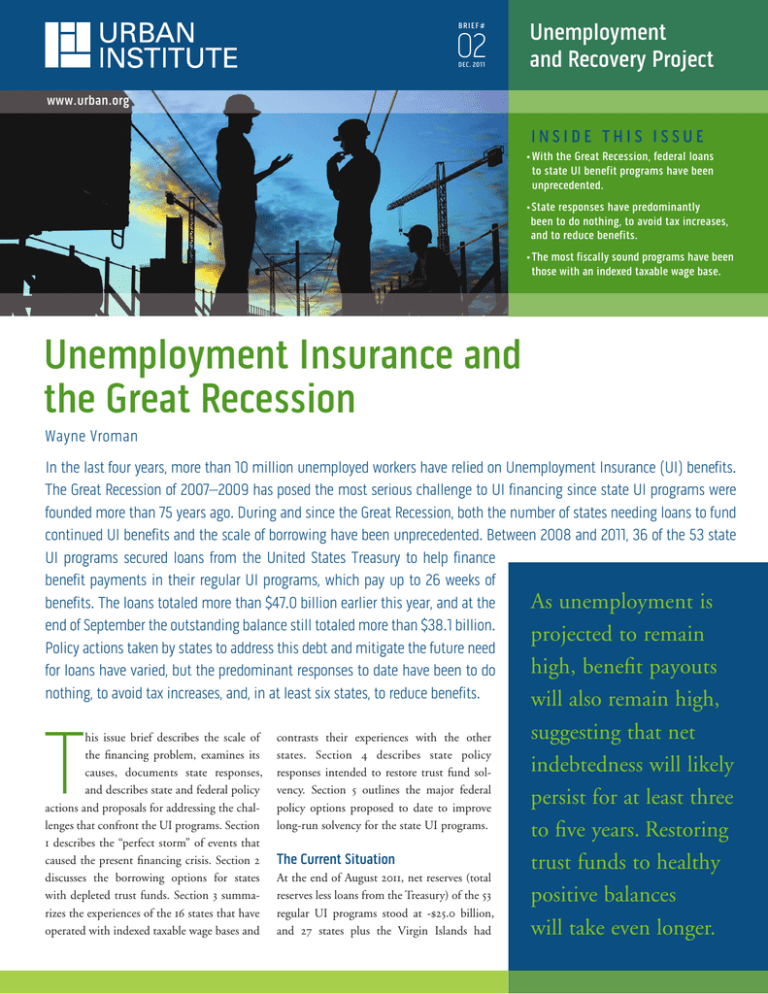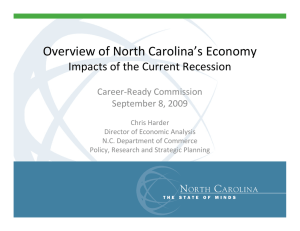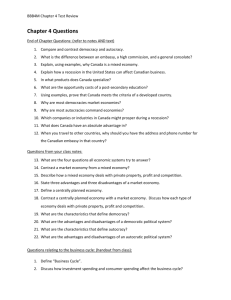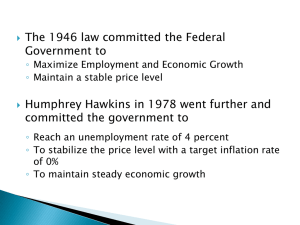02 Unemployment and Recovery Project
advertisement

bRIef # 02 dec. 2011 Unemployment and Recovery Project www.urban.org InsIde ThIs IssUe • With the Great Recession, federal loans to state UI benefit programs have been unprecedented. •state responses have predominantly been to do nothing, to avoid tax increases, and to reduce benefits. •The most fiscally sound programs have been those with an indexed taxable wage base. Unemployment Insurance and the Great Recession Wayne Vroman In the last four years, more than 10 million unemployed workers have relied on Unemployment Insurance (UI) benefits. The Great Recession of 2007–2009 has posed the most serious challenge to UI financing since state UI programs were founded more than 75 years ago. During and since the Great Recession, both the number of states needing loans to fund continued UI benefits and the scale of borrowing have been unprecedented. Between 2008 and 2011, 36 of the 53 state UI programs secured loans from the United States Treasury to help finance benefit payments in their regular UI programs, which pay up to 26 weeks of benefits. The loans totaled more than $47.0 billion earlier this year, and at the As unemployment is end of September the outstanding balance still totaled more than $38.1 billion. projected to remain Policy actions taken by states to address this debt and mitigate the future need high, benefit payouts for loans have varied, but the predominant responses to date have been to do nothing, to avoid tax increases, and, in at least six states, to reduce benefits. will also remain high, T his issue brief describes the scale of the financing problem, examines its causes, documents state responses, and describes state and federal policy actions and proposals for addressing the challenges that confront the UI programs. Section 1 describes the “perfect storm” of events that caused the present financing crisis. Section 2 discusses the borrowing options for states with depleted trust funds. Section 3 summarizes the experiences of the 16 states that have operated with indexed taxable wage bases and contrasts their experiences with the other states. Section 4 describes state policy responses intended to restore trust fund solvency. Section 5 outlines the major federal policy options proposed to date to improve long-run solvency for the state UI programs. The current situation At the end of August 2011, net reserves (total reserves less loans from the Treasury) of the 53 regular UI programs stood at -$25.0 billion, and 27 states plus the Virgin Islands had suggesting that net indebtedness will likely persist for at least three to five years. Restoring trust funds to healthy positive balances will take even longer. Unemployment Insurance and the Great Recession collective outstanding Treasury loans of $38.2 billion. Additionally, Idaho and Texas had combined outstanding loans in the private securities market of about $2.0 billion. This total indebtedness of some $40 billion represents about 0.8 percent of covered payroll, the highest of any recessionary period. The present scale of state UI trust fund indebtedness reflects the combined effects of four factors: (1) low prerecession reserve balances, (2) the unusual depth and duration of the recession, (3) the timing of the downturn, and (4) the continuing loss of employment and UI tax revenues caused by the recession and the slow recovery. While the first two factors have been mainly responsible for current indebtedness, the final two have also contributed to the loss of trust fund reserves. UI Trust fund Reserves Were Low before the Recession Even before the recession began, many states had historically low nonrecession UI trust fund levels. A common measure of UI reserve adequacy is the reserve ratio multiple (or RRM).1 A prerecession RRM of 1.0, representing reserves equal to 12 months of benefits at the highest previous level of UI benefit payouts, is generally believed to provide adequate prerecession reserves. The RRM at the end of 2007 was 0.36, meaning that aggregate reserves represented only 4.3 months of benefits when paid at the highest prior payout rate. (In contrast, the next lowest prerecession RRM was 0.91, prior to the recession of 1980.) The Recession Was Unusually deep The recession that started in November 2007 was the deepest and longest of the entire post–World War II period. Between 2007 and 2009 the national unemployment rate doubled, from 4.6 percent to 9.3 percent, increasing again in 2010 to 9.6 percent and averaging 9.1 percent so far in 2011. Unemployment averaged 14.8 million in 2010 and has remained above 13.5 million this year. Associated with increased unemployment has been an increase in average unemployment duration, which reached an unprecedented 24.4 weeks in 2009 and 33.0 weeks in 2010. Payouts of state-financed regular UI benefits have increased with the unemployment rate. Regular UI benefits increased from $32.2 billion in 2007 to $78.5 billion in 2009 and $58.2 billion in 2010. These payouts have caused large reductions in state UI trust funds. The Timing of the downturn Increased recession-related benefit payouts began in the last half of 2008, when roughly $10.0 billion more was paid out than in the same six months of 2007. Because most states determine taxes for the upcoming year based on June 30 trust fund balances, the increased payouts of late 2008 had little effect on UI taxes in 2009. The delayed response of taxes contributed to the decline in trust fund balances during 2009 as net reserves decreased by more than $44 billion. continuing Low UI Tax Revenue after the Recession Although officially the Great Recession ended in mid-2009, employment has continued to grow slowly. If UI-taxable employment had grown 1.0 percent per year after 2007, it would have reached 110.0 million in 2010, whereas actual employment was only 99.5 million in 2010. The employment shortfall has been roughly 10.0 percent in 2009, 2010, and 2011. As a consequence, UI tax revenue during the period 2009–2011 has been depressed by at least $3.0 billion per year, and the shortfall will continue into later years. The confluence of these four factors can be characterized as a perfect storm in their combined effects on state UI trust fund balances. With limited or negative reserves, modest increases in revenue, continuing benefit payouts, and interest on outstanding loans, states will need to take action to restore their UI trust funds. State options include borrowing funds, increasing tax revenues, and cutting benefits. state borrowing Options States that have inadequate UI reserves and that need loans to pay benefits have two broad borrowing options: from the U.S. Treasury or from the private capital market. Over the history of the UI program, the majority of states have used advances from the U.S. Treasury when they need funds, under loan provisions specified in Title XII of the Social Security Act. From 1974 to 1976, 25 separate programs borrowed a total of more than $5.5 billion, and between 1980 and 1987, 32 different programs borrowed a total of $24.0 billion; more recently, seven states needed loans in the recession of the early 1990s, and eight borrowed from the Treasury between December 2002 and December 2004. Borrowing during and after the Great Recession has been the most widespread and extensive of any post–World War II recessionary period. To date, 36 programs have borrowed, and net indebtedness (the difference between gross reserve balances and outstanding loans) is the highest ever recorded. Negative net reserves represented 0.68 percent of total covered payroll, the largest year-end negative net reserve ratio ever experienced by the state UI programs. In contrast to the relatively frequent use of Treasury loans, borrowing in the private securities market has been infrequent. To date only seven states have borrowed in the private market. Because these two borrowing options have different consequences and are best suited to different fiscal situations, states should understand the details of both in order to make the best short- and long-term decisions regarding financing their UI obligations. A longer companion paper describes important details associated with the two 2. Unemployment Insurance and the Great Recession figure 1. Taxable Wage Proportions in 2009 0.75 Taxable wage proportion 0.60 Ten big states Indexed states 0.45 0.30 0.15 0.00 0.00 0.10 0.20 0.30 0.40 0.50 0.60 0.70 0.80 0.90 1.00 Tax-base-to-average-wage ratio Source: U.S. Department of Labor, Handbook of Unemployment Insurance Financial Data, columns (5), (6), and (14). Calculations by author. types of loans.2 That paper reaches four main conclusions: (1) The interest rate will almost always be lower in the private securities market. (2) The average daily loan balance will always be lower for Treasury loans if optimal debt management is followed. This is as important as the interest rate in determining borrowing costs. (3) Comparisons of borrowing costs must consider all factors in the cost of loans, not just interest rates. (4) All loan options involve uncertainties that can be reduced but not eliminated. Three important uncertainties are the future strength of the state’s economy, which affects repayment under both types of borrowing; future interest rates on Treasury loans; and the future term structure and the average level of interest rates in the private securities market. This final uncertainty spans a range of debt instruments that a state might utilize if it enters the private market. states with Indexed UI Tax bases have More fiscally sound UI systems The UI program is funded by applying a tax rate to the taxable wage base (i.e., earnings that are subject to the UI tax). The revenue raised depends on the taxable wage base, the actual earnings of workers, and the tax rate. In 2011, 16 states plus the Virgin Islands operate UI programs with indexed taxable wage bases; indexation percentages vary between 50 and 100 percent of average covered earnings. The UI tax base in these states increases automatically with increases in statewide average covered earnings. If the tax base is high (i.e., if a high percentage of earnings is taxed), tax rates can be lower and still raise reasonable revenues; in contrast, if the tax base is low, a higher tax rate is necessary to maintain reserves. On average, indexed programs have much higher tax bases than programs with nonindexed tax bases. Of the 35 nonindexed programs, 21 have bases of $10,000 or less in 2011, meaning that UI taxes are paid on only the first $10,000 of earnings.3 The simple averages of the tax bases for the two groups in 2011 are $27,656 for the indexed programs and $10,313 for the nonindexed programs. Similarly, in 2010, the average taxable wage proportion (the ratio of taxable to total payroll) was 0.546 in the indexed programs compared to 0.249 in the nonindexed programs. In addition, recent recession-related borrowing among the indexed programs was less likely and involved smaller loans: of 16 indexed programs, only 6 (37.5 percent) borrowed during the period 2009–2011, compared to 29 of 35 nonindexed programs (82.9 percent). Figure 1 displays taxable wage proportions for 25 state UI programs in 2009, including the 10 nonindexed programs with the highest employment levels and 15 indexed programs. The relationships and contrasts in 3. Unemployment Insurance and the Great Recession the tax-base-to-average-wage ratios and the taxable wage proportions are vivid: the two are correlated, and both ratios are much lower for the nonindexed programs. Finally, as the tax base rises it exceeds the annual earnings of an increasing share of workers: equal increments in the tax base yield smaller and smaller increases in taxable wages. The tax base in states with indexed programs grows automatically with the growth in nominal wages. In the nonindexed large states wage growth has far outstripped increases in the tax base, and as a result the taxable wage proportions have declined. All 10 proportions were less than 0.30 in 2009. In the indexed states the taxable wage proportion in 2009 was 0.45 or higher for all but one (Oklahoma). All 10 big states in figure 1 borrowed from the Treasury during the period 2009–2011. The presence of a high tax base alone does not guarantee trust fund solvency for a state. It is also theoretically possible for a state to generate sufficient tax revenue from a low tax base through a very high average tax rate on taxable wages. In practice, however, there is a strong empirical relationship between a high tax base and a lack of borrowing during and after the Great Recession. The indexed programs, on average, have maintained much higher reserve balances than the other state UI programs. Given this empirical relationship, it seems logical that to run fiscally sound UI programs states should follow UI policies that generate higher tax bases. state Policy Responses to Restore UI Trust funds States more urgently need to address their trust fund loans at this point because of the increasing financial costs of indebtedness in combination with sluggish economic revival and strained state government finances. Given this situation, state policy responses to the Great Recession have varied widely.4 At one end of a spectrum, five states (Maryland, New Hampshire, South Dakota, Tennessee, and West Virginia) took aggressive actions to avoid or minimize the volume of borrowing. Their actions included both traditional responses such as experience-rated tax rate increases and selected benefit reductions, and new measures such as temporary part-year tax increases triggered by low trust fund balances. At the opposite extreme, the majority of states have yet to enact any policies to improve the balance between tax revenue and benefit payments. In fact, in several instances states have acted to prevent experience-rated tax increases, making their fiscal situation worse.5 Some states have increased their taxable wage bases, including three (Colorado, Rhode Island, and Vermont) where tax base indexation is going to be implemented. Several states have recently reduced access to UI benefits to reduce payouts. During 2011 six states (Arkansas, Florida, Michigan, Missouri, Pennsylvania, and South Carolina) passed laws to reduce the maximum duration of state UI benefits below 26 weeks. Other benefit reductions have included increases in disqualification penalties, requalification requirements, and oversight of payment accuracy. These same states rejected tax increases as a strategy for achieving improved future program solvency. Thus the policy actions taken by the state UI programs, when considered collectively, show some diversity; however, the predominant response has been to avoid the tax increases needed to restore their trust funds to large positive balances. federal Policy Proposals The pace of legislation to address these solvency issues has also been slow at the federal level. Both the Obama administration’s budget proposal for Fiscal Year 2012 and a bill sponsored by Senators Durbin, Reed, and Brown (the Unemployment Insurance Solvency Act of 2011, Senate bill S.386.IS) have proposed raising the federal UI taxable wage base and providing financial rewards to debtor states that make large improvements in program solvency. Both initiatives raise the federal UI tax base from its current $7,000 to $15,000 in 2014 and index the base to nationwide wage growth in subsequent years. Since total federal UI revenues would increase sharply, both proposals would decrease the federal tax rate to make the change in the federal UI taxes roughly revenue neutral. This would affect tax revenue in many states (those with tax bases below $15,000) because all states are required to have tax bases at least at the level of the federal tax base. Both proposals provide partial debt forgiveness to states that substantially improve solvency and restore trust fund balances within a seven-year time horizon. Unfortunately, neither initiative has moved forward since being introduced in early 2011. Both proposals imply that substantial UI tax increases will take place during most remaining years of the current decade. A third legislative proposal, the Jobs, Opportunity, Benefits and Services Act of 2011, House bill H.R. 1745 sponsored by representatives Camp, Davis, and Berg, was introduced in the House of Representatives in May. This bill proposes strengthening job search requirements and making claimants’ participation in employment services mandatory, and it shortens the potential duration of emergency federal UI benefits. It also overrides existing regulations that require higher state UI taxes when state trust funds are depleted. The bill proposes a federal transfer of $31 billion into state UI trust funds during fiscal years 2011 and 2012 but allows these new monies to be used for more than paying UI benefits; in effect, this bill places an increased burden of adjustment on UI claimants through increased entry requirements, increased disqualifications, and reduced access to federal UI benefits. It also 4. Unemployment Insurance and the Great Recession potentially relieves employers from some of the future costs of supporting the regular UI program as debt repayment is one of the possible uses of the federal disbursement. The bill was passed by the House of Representatives but has not advanced in the Senate. Compared to the Durbin and Obama administration proposals, the Camp proposal would bring about smaller solvency adjustments by the states especially in the long run, as it actually would restrain the growth of future state UI tax revenue. The slow pace of the state and federal policy response to the financing problem means that state UI trust fund debts will be present for several more years. Only this year has the overall net indebtedness of the state trust funds stopped increasing. However, current indebtedness of just less than $40 billion represents roughly one full year of national UI tax revenue at present rates of collections. A $40 billion differential between revenue and benefits is needed just to bring the aggregate trust fund balance back to zero. As unemployment is projected to remain high, benefit payouts will also remain high, suggesting that net indebtedness will likely persist for at least three to five years. Restoring trust funds to healthy positive balances will take even longer. The present situation requires difficult decisions to be made at both the state and federal levels, decisions that could include making major changes to the current structure of the state UI programs. • 1. The RRM is a ratio of two ratios. The numerator ratio is the reserve ratio, defined as reserves as a percentage of payroll. This ratio was 0.79 percent at the start of the recession, on December 31, 2007. The denominator ratio is the highest previous annual benefit payout rate, also measured as a percentage of payroll. The highest payout rate was 2.22 percent during 1975. Thus the RRM at the end of 2007 was 0.79/2.22, or 0.36. 2. Wayne Vroman, “Unemployment Insurance and the Great Recession” (Washington, DC: The Urban Institute, 2011), http://urban.org/unemployment/. 4. A paper on which this brief is based provides details of the state responses. See Wayne Vroman, “Unemployment Insurance and the Great Recession” (Washington, DC: The Urban Institute, 2011), http://urban.org/unemployment/. About the Author Unemployment and Recovery Project notes Wayne Vroman is a senior fellow in the Urban Institute’s Center on Labor, Human Services, and Population. The National Academy of Social Insurance has recognized Dr. Vroman as a distinguished honoree for his research in unemployment insurance. 3. In contrast to the generally low UI tax bases, the 2011 tax base for Social Security is $106,800, or about 2.5 times average earnings, and the taxable wage proportion is about 0.85. 5. Ibid. This brief is part of the Unemployment and Recovery project, an Urban Institute initiative to assess unemployment’s effect on individuals, families, and communities; gauge government policies’ effectiveness; and recommend policy changes to boost job creation, improve workers’ job prospects, and support out-of-work Americans. Copyright © December 2011 The views expressed are those of the authors and do not necessarily reflect those of the Urban Institute, its trustees, or its funders. Permission is granted for reproduction of this document, with attribution to the Urban Institute. URbAn InsTITUTe 2100 M street, nW ● Washington, dc 20037-1231 (202) 833-7200 ● paffairs@urban.org ● www.urban.org 5.








